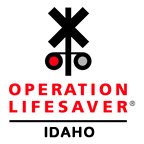 The nationwide non-profit public safety program “Operation Lifesaver” was implemented to raise awareness and promote education to keep citizens safe at train crossings. The program began in Idaho in 1972. Each year the Idaho State Police (ISP) conducts its “Cops on Trains” to spend the day patrolling railroad crossings and stop motorists who try to drive past lowered crossing gates and/or around barriers.
The nationwide non-profit public safety program “Operation Lifesaver” was implemented to raise awareness and promote education to keep citizens safe at train crossings. The program began in Idaho in 1972. Each year the Idaho State Police (ISP) conducts its “Cops on Trains” to spend the day patrolling railroad crossings and stop motorists who try to drive past lowered crossing gates and/or around barriers.
Travis Campbell, the Operation Lifesaver coordinator for Idaho, says “Cars are not built to be taking impacts for trains. The weight ratio between your car and a soda can is about the weight ratio between the train and your car.” The odds of surviving a crash with a train are 4,000 to 1. When a law enforcement officer is dispatched to respond to a vehicle versus train crash, they anticipate fatalities. Operation Lifesaver spreads awareness through the three Es: Education, Engineering, and Enforcement.
Vehicle versus train crashes are totally preventable. In Idaho it is unlawful to pull out in front of a train that is 1500 feet of a crossing or is dangerously close to the crossing. It is also unlawful to drive any vehicle around or under any crossing gate or barrier. See I.C. § 49-648. When you see the flashing lights at a rail crossing, HIT THE BRAKES and STOP. Do not try to cross the tracks with a train approaching. That train you see approaching is closer and moves faster than you think. Never take a chance to try to beat the train; it is better to arrive late than not at all. Additional information about Operation Lifesaver and Rail Safety is available at www.oli.org
If you have suffered a loss as a result of a train v motor vehicle wreck, call the personal injury lawyers at Racine Olson at: 208-232-6101. The Racine Olson team of lawyers has expertise in accidents involving trains and has successfully recovered settlements for their clients.
This website includes general information about legal issues and developments in the law. Such materials are for informational purposes only and may not reflect the most current legal developments. These informational materials are not intended, and must not be taken, as legal advice on any particular set of facts or circumstances. You need to contact a lawyer for advice on specific legal issues.
 Idaho Law Blog
Idaho Law Blog

